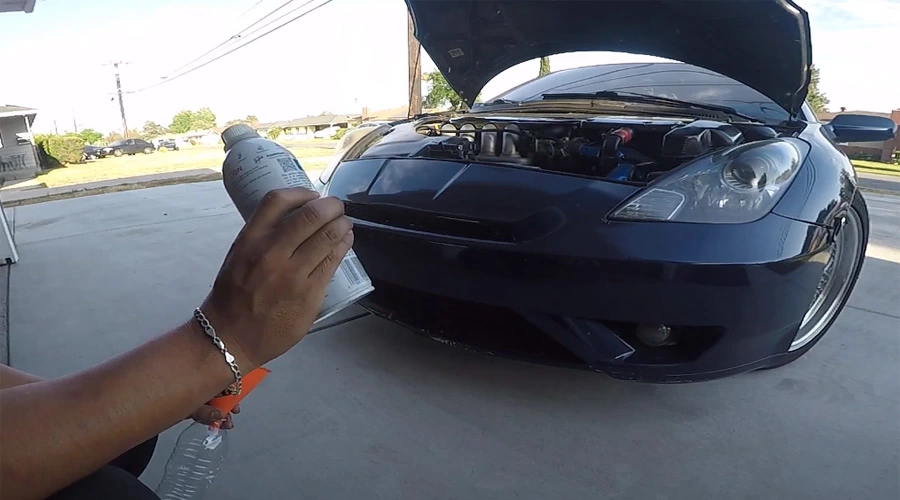If you are wondering how to use SeaFoam to clean catalytic converter, there is one crucial thing that you have to remember. SeaFoam doesn’t necessarily clean the catalytic converters. And instead, it helps clean the carbon from the engine to make this pass-through catalytic converter without causing clogging in it.
The catalytic converter is the one that controls the exhaust emission by reducing toxic gases and pollutants from the combustion engine to transform them into less dangerous pollutants through catalyzing the reaction of reduction and oxidation.

Once a catalytic converter gets exposed to the exhaust-containing substances coating the working surfaces, this can get damaged. The damage is commonly called catalyst poisoning. The most prominent contaminant here is lead, and vehicles with catalytic converters can run solely on unleaded fuel. The rest of the impurities like sulfur and manganese from the gasoline additives could find their way to the exhaust stream.
How seafoam works
Many things work altogether in the engine of your car so that you can drive around in it. After some time, the engine’s internal parts could end up clogged that can reduce the life and performance of the engine. Varnish and tar may accumulate on the crankcase parts like the lifters, oil galleries, rings, and pistons. Sooner or later, this buildup can reduce the ability of the engine to lubricate and cool itself.
This buildup can also occur inside the fuel systems and clog up the intake valves, pistons, and carburetor jets. It can have a significant effect on the engine’s breathing and may cause hotspots if there are carbon deposits present in the pistons or valves. These hotspots lead to detonations and reduced engine performance. You have to make sure that your engine is always clean to prevent these problems. This is precisely where SeaFoam enters the picture.
SeaFoam has already been used for many years and is among the most trusted and effective treatments for vehicle engines. This is specially made to reliquefy sludge, gum, varnish, and carbon deposits from the complex parts of the engine to flush them out quickly.
SeaFoam can also lubricate the fuel system’s moving parts. Continuous use of the ethanol additives in the engine can leave the seals with varnish and dry, making it difficult to lubricate the parts with oil. Getting rid of the varnish can help bring the machine back to its optimum performance.
SeaFoam can also absorb the water present inside the fuel tank to allow burning the fuel without any problem within the combustion chamber.
How to clean the fuel system with seaFoam
You can use SeaFoam in any diesel or gasoline engine. SeaFoam is most commonly used in storage, oil, and fuel.
Total Time: 35 hours
1. SeaFoam for Oil
SeaFoam added to the crankcase of the engine oil can work to liquefy and clean heavier deposits of oil. A single can of SeaFoam treats up to 16 quarts of oil, which means that you can get a couple of treatments in one can for the majority of vehicles.
To get the best results, make sure that you add this treatment when you are 1,000 or fewer miles to your next oil change. The rest can be added after changing the oil. It helps drain away dangerous residues once the oil has been changed. The second treatment cleans the internal parts of the engine and prevents sludge as well as other harmful oil formations.
Start the procedure by removing the oil filler neck’s cap. Add SeaFoam to your oil tank after or before the oil change. Pour one ounce of the SeaFoam treatment into the engine for every quart of oil. Half a bottle can be used for every treatment. Put back the cap then allow the Seafoam to work its magic.
2. SeaFoam for Storage
As you prepare your engines for seasonal storage, the SeaFoam can function as a stabilizer, keep the fuel fresh, prevent the formation of varnish and gum, and keep the passageways always clean. This can also control the moisture amount and preserve the ignition vapors for the engines to have an easier start.
3. SeaFoam for Fuel
SeaFoam once added to fuel can work to lubricate and clean passageways. This allows the engine to start easier as well as run smoother with additional power. This also functions in cleaning the carburetors in the gasoline engines and the fuel injectors in diesel and gasoline engines. SeaFoam can also clean the dangerous deposits from the combustion chamber areas and intake valves and lubricates the upper cylinders.
A single can treats 16 gallons of fuel, which means that half a can is already enough. SeaFoam, when used in diesel engines, will add anti-gel properties and de-ice. This can also control moisture and stabilize the fuel in all types of engines.
All you have to do here is open the lid of the fuel tank and use a funnel to pour up to half the bottle into the fuel tank.
How do you clean the catalytic converter?
The catalytic converters lower carbon footprint and pollution drastically by transforming exhaust emissions into less dangerous compounds not only for humans but also for the environment. After several years of usage, the catalytic converters can turn dirty and must be cleaned for your vehicle to run in its best condition.
If the catalytic converter of your car has been blocked up with the carbon deposits or has become dirty, this will show some symptoms such as the following:
- Reduced engine performance and acceleration
- Emission of the black exhaust fumes and smoke with rotten egg-like smell
- High temperatures below the vehicle
- P0420 error code that says the computer of the vehicle detects an issue with the catalytic converter
Cleaning your catalytic converter can clear both error codes and symptoms. You will be able to clean the catalytic converter by removing or not removing it.
The Bottom Line
SeaFoam works are amazing to ensure that your engine, specifically catalytic converter, doesn’t get dirty or clogged up. Its regular use can help save you from many trips to the car shop and the need to clean your converter. However, once you notice symptoms of a clogged converter, SeaFoam won’t be able to do that much. Therefore, a manual cleanse or a catalytic converter cleaner might be necessary.



